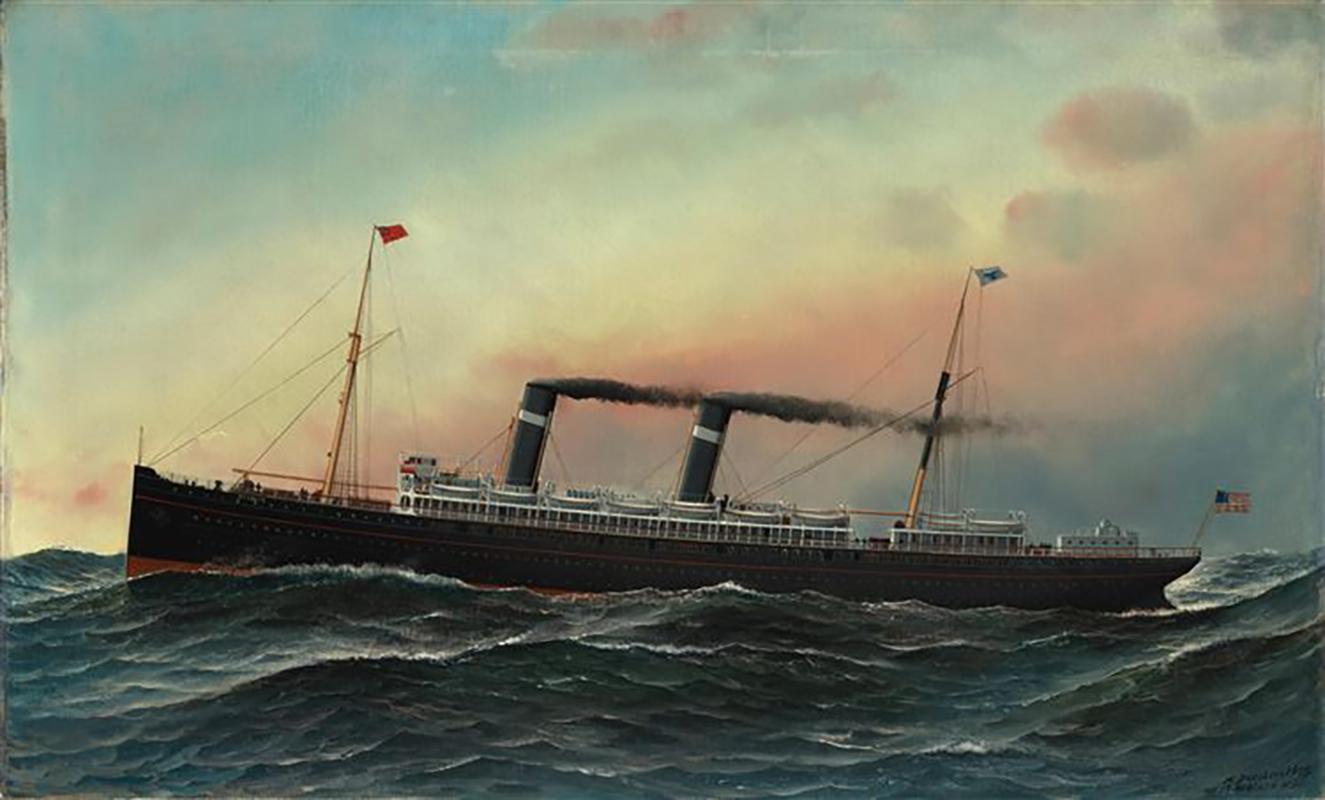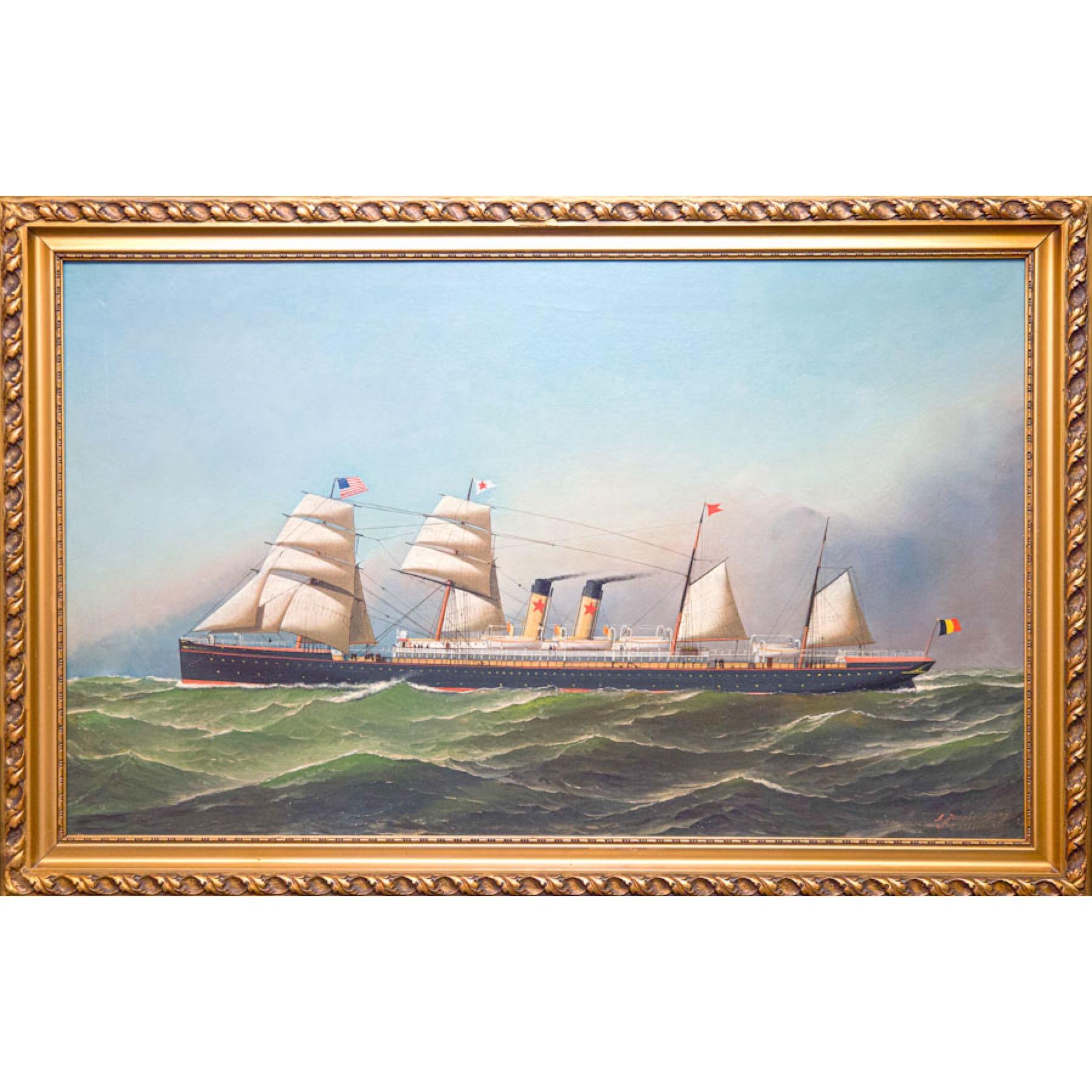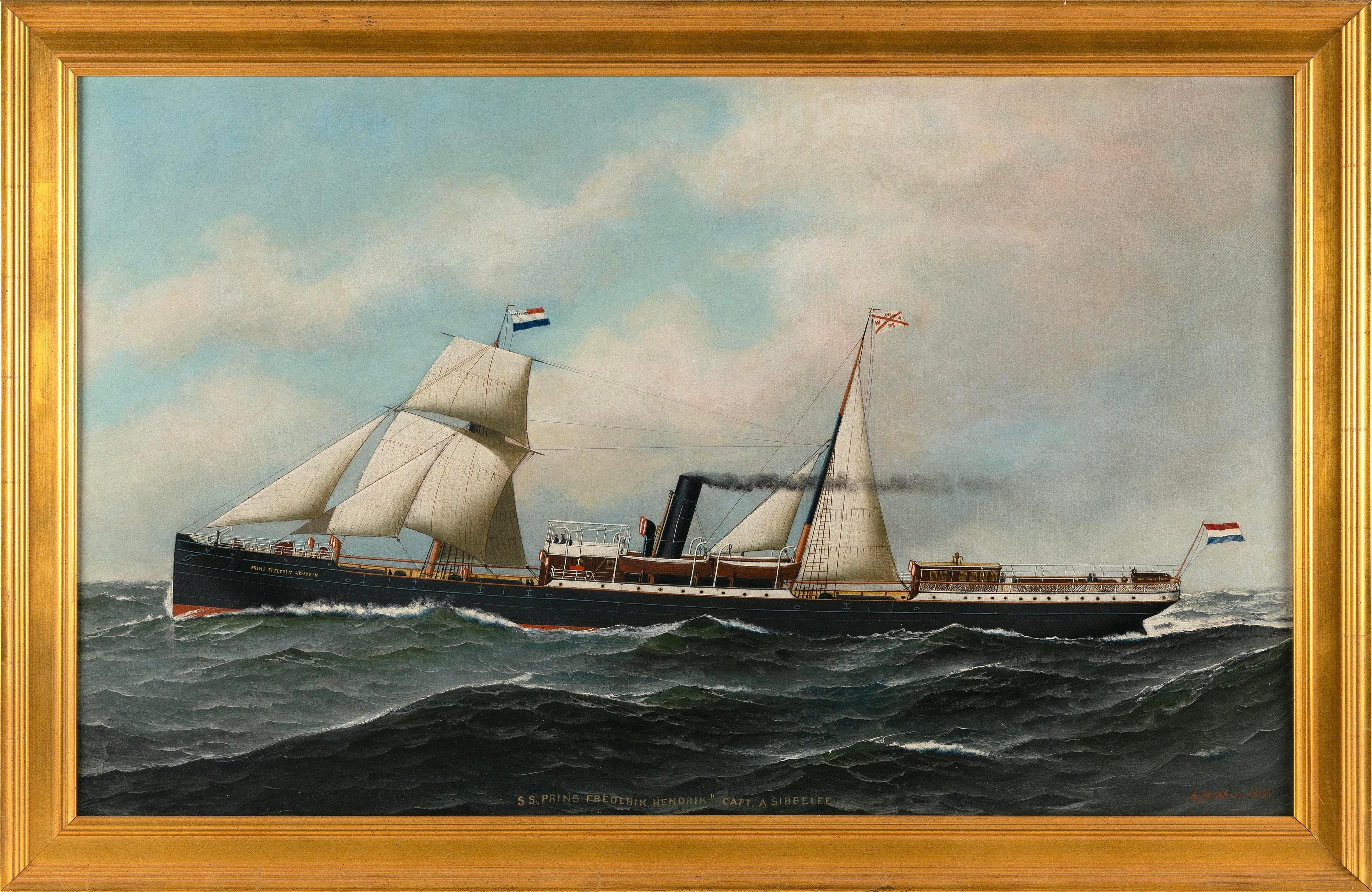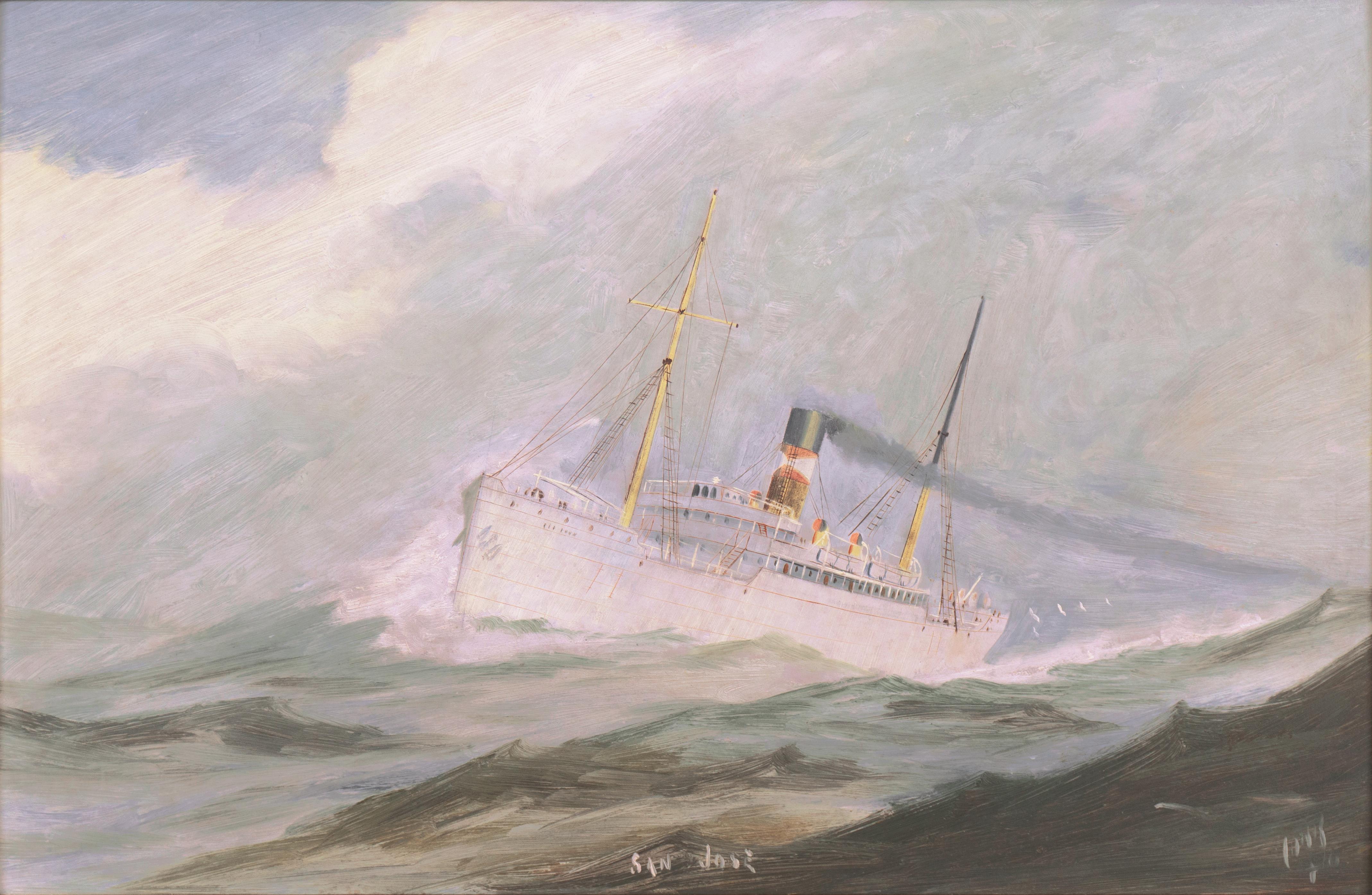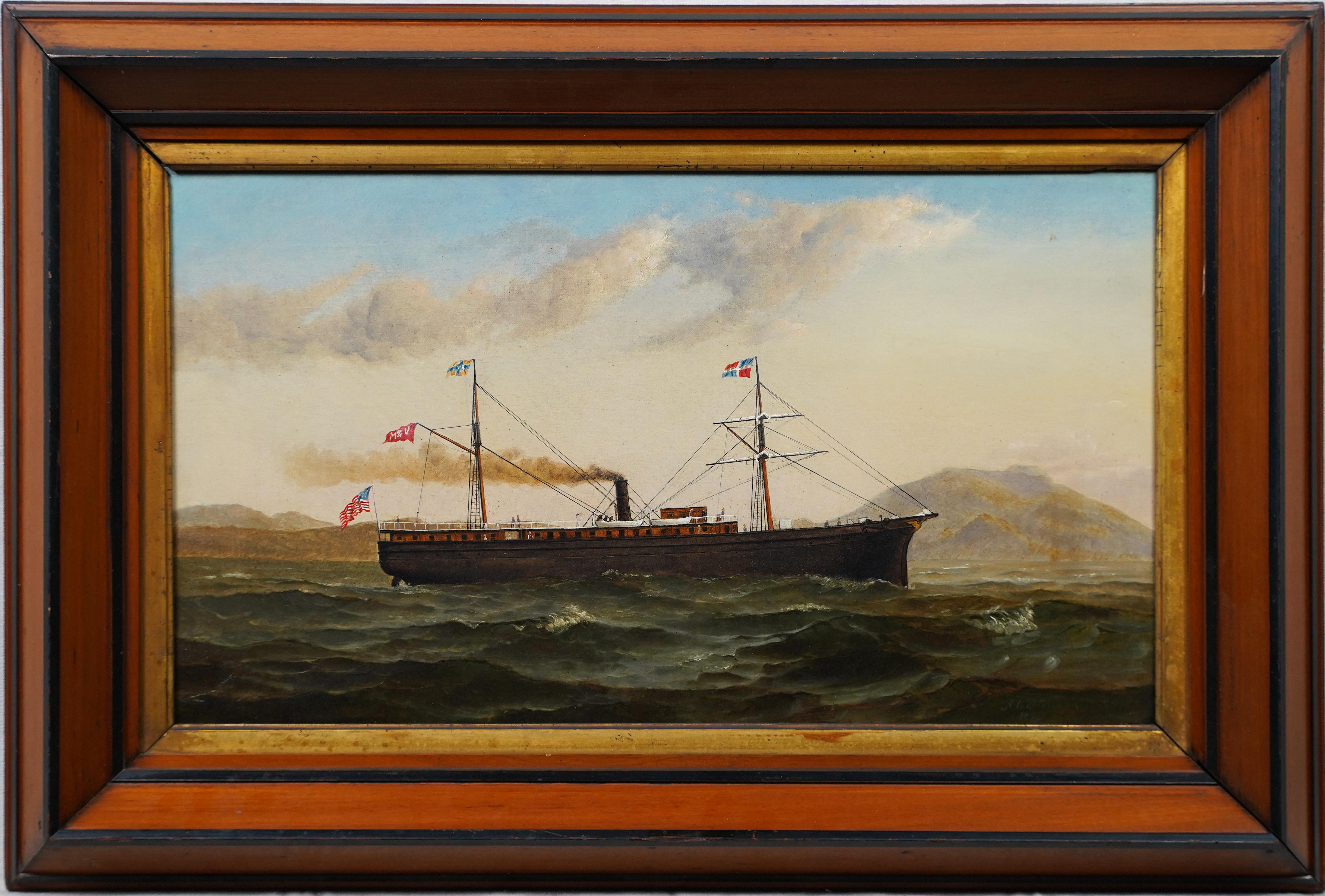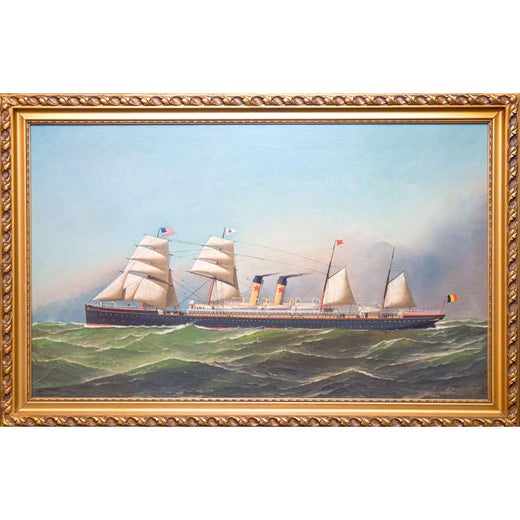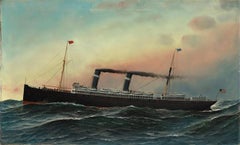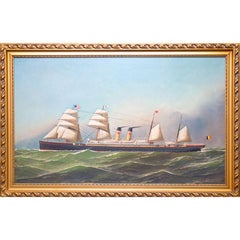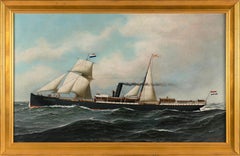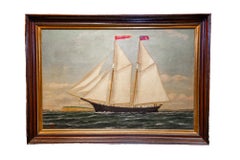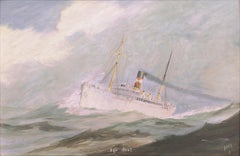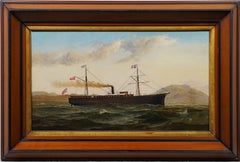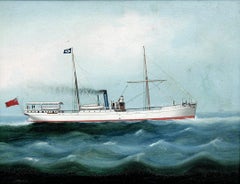Items Similar to Portrait Of The Screw-Steamer Pennland In New York Harbor
Video Loading
Want more images or videos?
Request additional images or videos from the seller
1 of 13
Antonio Nicolo Gasparo JacobsenPortrait Of The Screw-Steamer Pennland In New York Harbor1887
1887
$38,000
£28,854.30
€32,997.05
CA$53,091.51
A$59,049.35
CHF 30,833.74
MX$718,567.76
NOK 393,793.85
SEK 369,309.16
DKK 246,269.61
Shipping
Retrieving quote...The 1stDibs Promise:
Authenticity Guarantee,
Money-Back Guarantee,
24-Hour Cancellation
About the Item
ntonio Nicolo Gasparo Jacobsen’s Portrait of the Screw-Steamer Pennland in New York Harbor captures the grandeur of maritime travel in the late 19th century. The painting depicts the Pennland, a majestic steamship, cutting through the waters of New York Harbor with billowing smoke rising from its funnel. The vessel is painted with Jacobsen’s signature precision, showcasing the intricate details of its hull, rigging, and deck structures. The serene yet powerful presence of the ship is set against a dynamic harbor scene, where smaller vessels dot the waters and the soft hues of the sky reflect on the gentle waves. Jacobsen’s expert use of perspective and lighting lends a sense of depth and realism, making the viewer feel as though they are witnessing the ship’s arrival firsthand.
As one of the most prolific maritime painters of his time, Jacobsen played a crucial role in documenting the golden age of steam travel. His works, including this detailed portrait of the Pennland, not only celebrate the engineering feats of the era but also serve as historical records of significant vessels. The transition from sail to steam was a defining moment in maritime history, and Jacobsen’s meticulous paintings capture this evolution with remarkable accuracy. His contributions to the maritime art movement remain invaluable, preserving the legacy of the great ships that once traversed the world’s oceans.
Provenance: Reference and notes:
Antonio Jacobsen - The Checklist: Paintings and Sketches by Antonio N.G. Jacobsen (1850-1921) by Harold S. Sniffen (N.Y. and Newport News, Va.: The Mariners' Museum, 1984), p. 242. Sniffen notes Pennland as a sketch only, not a finished oil, though he also writes that of the 2,200 sketches in the Mariners' Museum collection, 1,450 of them have no known corresponding oil painting.
The discovery of this finished oil painting of the Pennland, depicted in New York Harbor, make it a particularly exciting and desirable maritime work.
27488-LU2595213678562
- Creator:Antonio Nicolo Gasparo Jacobsen (1850 - 1921, American)
- Creation Year:1887
- Dimensions:Height: 22 in (55.88 cm)Width: 36 in (91.44 cm)
- More Editions & Sizes:22" x 36"Price: $38,000
- Medium:
- Period:
- Condition:This piece and the accompanying frame are in GOOD Condition and deserve to be in the collection of an owner who truly appreciates them. We welcome all inquiries regarding design, construction, and condition.
- Gallery Location:Jacksonville, FL
- Reference Number:Seller: 274881stDibs: LU2595213678562
Jacobsen was born in Copenhagen, Denmark where he attended the Royal Academy of Design before heading across the Atlantic Ocean. He arrived in the United States in August 1873. He settled in West Hoboken, New Jersey (now Union City, New Jersey), across the Hudson River from Manhattan and New York Harbor, its port filled with ships from America and around the world. Jacobsen got his start painting pictures of ships on safes, and as his reputation grew, he was asked to do portraits of ships by their owners, captains and crew members, with many of his works selling for five dollars. Jacobsen painted more than 6,000 portraits of sail and steam vessels, making him "the most prolific of marine artists". Many of his commissions came from sea captains, and Jacobsen was chosen both for the accuracy of his work and his low fee. Exhibitions of Jacobsen's work include a 1996 showing of 45 of his paintings at the National Museum of American History. In 1995, the Mariners' Museum in Newport News, Virginia held an exhibition that included 80 paintings by Jacobsen. In conjunction with the exhibition, the museum published a volume by Harold S. Sniffen, the museum's curator emeritus, whose biography titled Antonio Jacobsen's Painted Ships on Painted Oceans, includes some 100 color pictures of the artist's ship paintings.
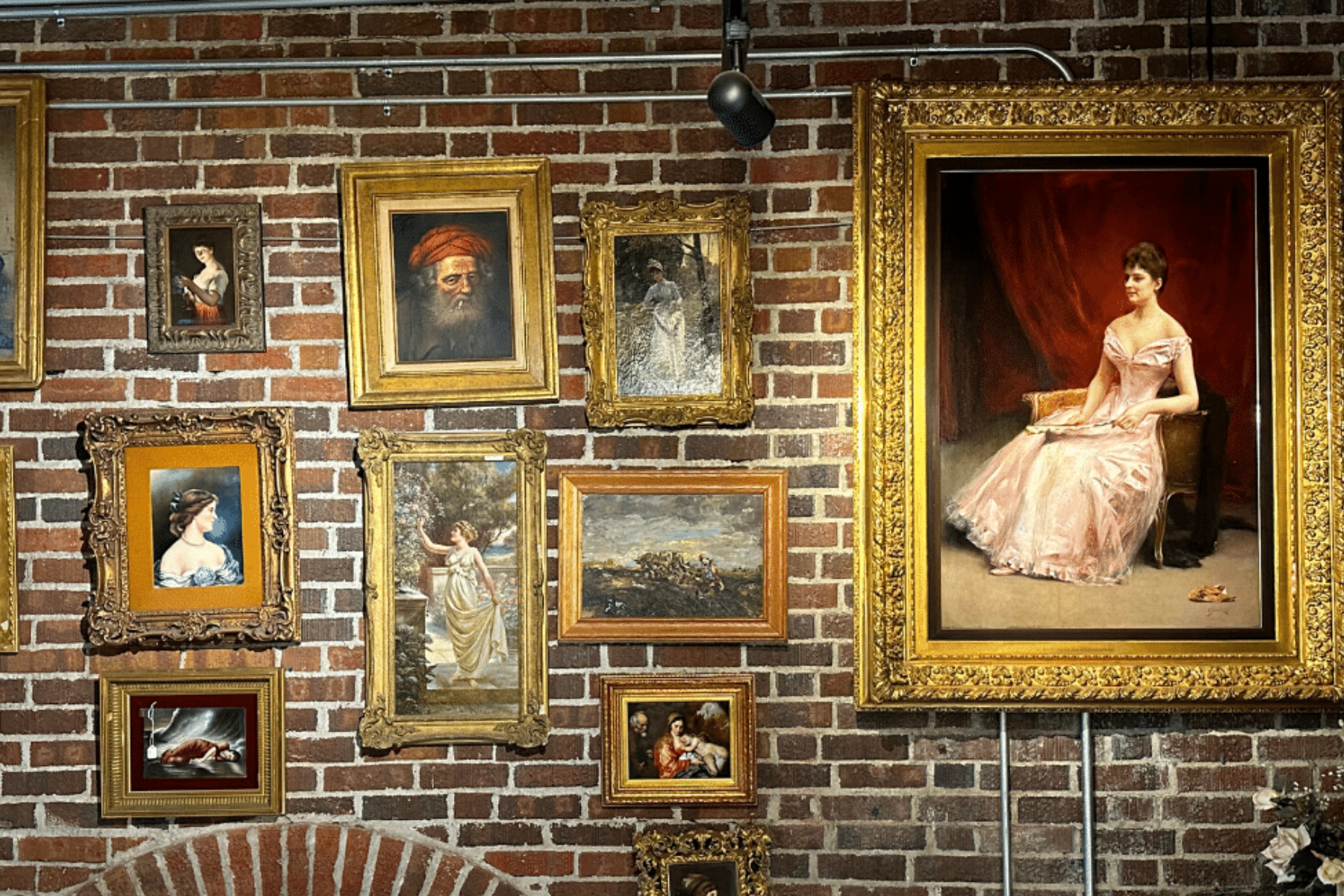
About the Seller
No Reviews Yet
Vetted Professional Seller
Every seller passes strict standards for authenticity and reliability
Established in 1960
1stDibs seller since 2023
16 sales on 1stDibs
Typical response time: 1 hour
- ShippingRetrieving quote...Shipping from: Jacksonville, FL
- Return Policy
Authenticity Guarantee
In the unlikely event there’s an issue with an item’s authenticity, contact us within 1 year for a full refund. DetailsMoney-Back Guarantee
If your item is not as described, is damaged in transit, or does not arrive, contact us within 7 days for a full refund. Details24-Hour Cancellation
You have a 24-hour grace period in which to reconsider your purchase, with no questions asked.Vetted Professional Sellers
Our world-class sellers must adhere to strict standards for service and quality, maintaining the integrity of our listings.Price-Match Guarantee
If you find that a seller listed the same item for a lower price elsewhere, we’ll match it.Trusted Global Delivery
Our best-in-class carrier network provides specialized shipping options worldwide, including custom delivery.More From This Seller
View AllThe American Steam-Sailer St. Louis
Located in Jacksonville, FL
The American Steam-Sailer St. Louis
signed, dated and inscribed 'A. Jacobsen 1899. / West Hoboken N.J.' (lower right)
oil on canvas
22 1/8 x 36 1/8 in. (56.2 x 91.8 cm.)
Painted in 1...
Category
19th Century Paintings
Materials
Oil
The Screw-Steamer Westernland.
Located in Jacksonville, FL
Antonio Nicolo Gasparo Jacobsen’s The Screw-Steamer Westernland captures the imposing presence and engineering prowess of this late 19th-century steamship. The vessel is depicted in motion, cutting through the waters with its towering masts and powerful steam funnel in full display. Jacobsen’s meticulous attention to detail brings the Westernland to life, from the carefully rendered hull and rigging to the soft ripples in the water reflecting the ship’s passage. The backdrop, a moody yet luminous sky, adds to the sense of movement and grandeur, emphasizing the ship’s role in the rapidly evolving maritime industry of the time.
Jacobsen, renowned for his precise and historically significant ship portraits, played a vital role in documenting the era’s most important vessels. His work on The Screw-Steamer Westernland exemplifies his ability to blend artistic finesse with technical accuracy, making his paintings invaluable both as historical records and as masterful works of art. His contributions to maritime painting ensured that the ships of his time would be immortalized with the same grandeur they once commanded on the open seas.
Provenance: Reference:
Antonio Jacobsen - The Checklist: Paintings and Sketches by Antonio N.G. Jacobsen (1850-1921) by Harold S. Sniffen (N.Y. and Newport News...
Category
19th Century Landscape Paintings
Materials
Canvas, Oil
Portrait Of The Steam/Sail Ship The Prins Frederik Hendrik.
Located in Jacksonville, FL
This oil is a classic example of Jacobsen's work from his best period done way before 1900. In these oils the water is done with great sense of naturalism, due to his constant experiences at the harbors in New York and New Jersey. It is his best work when the sails are up and the steam stacks are in full blast. An unusual note is that this painting is on its original canvas and is in extraordinary condition. Most Jacobsens have endured rounds of restoration which makes this painting's condition special.
This was a commissioned piece from the Captain of the flagship, Prince Frederik Hendrick, a great king during the Dutch golden age in the 17th century. The Captain was very proud of this vessel, and upon the safe entrance into the New York port, hired Jacobsen to commemorate this voyage.
Provenance: Reference:
Antonio Jacobsen - The Checklist: Paintings and Sketches by Antonio N.G. Jacobsen (1850-1921) by Harold S. Sniffen (N.Y. and Newport News...
Category
19th Century Landscape Paintings
Materials
Canvas, Oil
Portrait of the Schooner G.F. Hathaway. Dated 1877
Located in Jacksonville, FL
Portrait of the Schooner G.F. Hathaway. Dated 1877. Oil on canvas portrait of the 2-masted schooner G.F. Hathaway of St. John, New Brunswick under sail passing a lighthouse. signed a...
Category
19th Century Paintings
Materials
Oil
The Three Masted Schooner Samuel H. Hawes
Located in Jacksonville, FL
William Pierce Stubbs’ The Three-Masted Schooner Samuel H. Hawes is a striking maritime portrait that captures the majesty and strength of this g...
Category
Late 19th Century Landscape Paintings
Materials
Canvas, Oil
American Clipper Ship at Sea by Antonio Jacobsen, Signed and Dated 1917
By Antonio Jacobsen
Located in Jacksonville, FL
American Clipper Ship at Sea by Antonio Jacobsen, Signed and Dated 1917
This stunning maritime oil painting by renowned marine artist Antonio Jacobsen (1850–1921) captures a majesti...
Category
Early 20th Century American Realist Landscape Paintings
Materials
Oil
You May Also Like
"Ship Portrait, " William Edward Norton, Seascape Maritime Painting, New England
By William Edward Norton
Located in New York, NY
William Edward Norton (1843 - 1916)
Ship Portrait, 1876
Oil on canvas
10 x 16 inches
Signed and dated lower left
Born in Boston, William Norton became a noted marine painter, stirred by his youth when he sailed on family-owned ships. He studied at the Lowell Institute in Boston, and with George Inness, and then established a studio in Boston.
In the early 1870s, he went to Paris and became a student with Chevreuse and A. Vollon, and then he settled in London where he exhibited throughout the last quarter of the 19th century. His reputation there was based on his scenes of the Thames River, and ocean and coastal views.
In 1901, he and his wife returned to the United States and settled in New York City. He also painted at Monhegan Island, Maine, where a treacherous ledge on the southern side of the island is named "Norton's Ledge" for him.
He was a member of the Boston Art Club with whom he exhibited from 1873 to 1909. He also exhibited with the Pennsylvania Academy, the Royal Academy in London, the Paris Salon, the 1893 Chicago Exposition...
Category
1870s Hudson River School Landscape Paintings
Materials
Canvas, Oil
'The SS. San Jose', American Merchant Marine, United Fruit Company Freighter
Located in Santa Cruz, CA
The S.S. San Jose shown making way in medium water. This early refrigerated freighter, built in 1904, was designed to transport bananas between the Caribbean and the American mainlan...
Category
1910s American Realist Landscape Paintings
Materials
Oil, Board
Antique American School Signed 19th Century Nautical Seascape Framed Painting
Located in Buffalo, NY
Antique American nautical ship oil painting. Oil on canvas. Signed. Framed.
Category
1870s Realist Landscape Paintings
Materials
Canvas, Oil
$3,800 Sale Price
20% Off
19th Century British School Ship at Sea, Seascape Painting
Located in Beachwood, OH
19th Century British School
Ship at Sea
Oil on canvas laid on panel
11 x 14.5 inches
14.5 x 18 inches, framed
Frame has chips and paint loss. See photos.
Category
19th Century Figurative Paintings
Materials
Oil
New York Central Home Port
By Nicholas Berger
Located in Greenwich, CT
Nicholas Berger Biography
American, b. 1949
In his more than three decades as an artist, Nicholas Berger (b. 1949) has created an outstanding body of work that continues to evolve a...
Category
2010s American Realist Landscape Paintings
Materials
Oil, Panel
Maritime Oil Painting 19th century, by Prof. Alfred Jensen. Ship and Boat at Sea
By Alfred Jensen (b.1859)
Located in Berlin, DE
Maritime oil painting 19th century, by Prof. Alfred Jensen. Ship and boat at sea.
Around 1900. Signed lower left.
Unframed
Age-related condition.
Alfre...
Category
19th Century Landscape Paintings
Materials
Canvas, Oil
$2,396 Sale Price
20% Off
Free Shipping
More Ways To Browse
Screw Art
Antonio Jacobsen
Antique Harbor Paintings
Antique Ocean Painting
19th Century Harbor Paintings
Oil Painting Of Harbor 19th Century
19th Century Maritime Ship Painting
Steamship Paintings
Maritime Antiques
Steam Ship Painting
Oil Painting Steamship
Jacobsen Oil Painting
Antonio Jacobsen Oil Paintings
Very Large Antique Landscape Oil Paintings
White Poppy
16x20 Antique Frame
1980 Boats
Apple Trees
